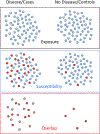Genes and environment in chronic kidney disease hotspots
- PMID: 30451737
- PMCID: PMC6763202
- DOI: 10.1097/MNH.0000000000000470
Genes and environment in chronic kidney disease hotspots
Abstract
Purpose of review: Chronic kidney disease (CKD) can cluster in geographic locations or in people of particular genetic ancestries. We explore APOL1 nephropathy and Balkan nephropathy as examples of CKD clustering that illustrate genetics and environment conspiring to cause high rates of kidney disease. Unexplained hotspots of kidney disease in Asia and Central America are then considered from the perspective of potential gene × environment interactions.
Recent findings: We report on evidence supporting both genes and environment in these CKD hotspots. Differing genetic susceptibility between populations and within populations may explain why causal environmental risk factors have been so hard to identify conclusively. Similarly, one cannot explain why these epidemics of kidney disease are happening now without invoking environmental changes.
Summary: Approaches to these CKD hotspots are of necessity becoming more holistic. Genetic studies may help us identify the environmental triggers by teaching us about disease biology and may empower environmental risk factor studies by allowing for stratification of study participants by genetic susceptibility.
Conflict of interest statement
Figures


References
-
- Freedman BI, Spray BJ, Tuttle AB, Buckalew VM Jr. The familial risk of end-stage renal disease in African Americans. Am J Kidney Dis. 1993;21:387–393. - PubMed
Publication types
MeSH terms
Substances
Grants and funding
LinkOut - more resources
Full Text Sources
Medical
Research Materials
Miscellaneous

